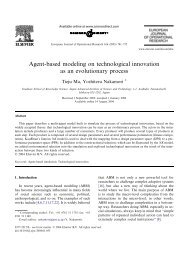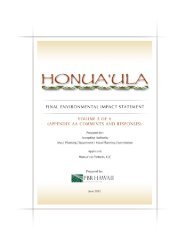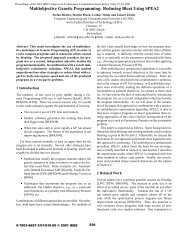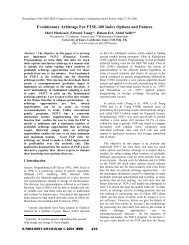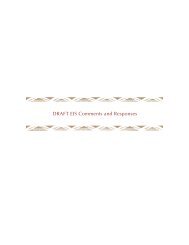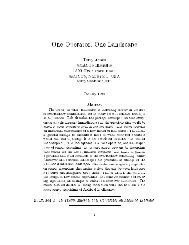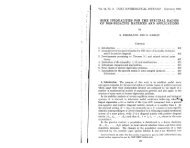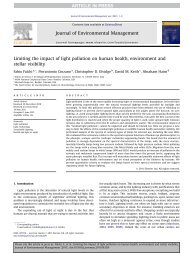4 description of the human environment, potential ... - Lee Altenberg
4 description of the human environment, potential ... - Lee Altenberg
4 description of the human environment, potential ... - Lee Altenberg
You also want an ePaper? Increase the reach of your titles
YUMPU automatically turns print PDFs into web optimized ePapers that Google loves.
Final Environmental Impact Statement<br />
Wailea Alanui Drive intersection improvements see Section 4.4 (Roadways and Traffic)<br />
and Appendix S, which contains <strong>the</strong> complete Wailea Ike Drive and Wailea Alanui Drive<br />
Intersection Improvements Final EA. Appendix G <strong>of</strong> <strong>the</strong> Final EA contains <strong>the</strong> SHPD letter<br />
regarding <strong>the</strong> need for archaeological monitoring plan for <strong>the</strong> Wailea Ike Drive and<br />
Wailea Alanui Drive intersection improvements.<br />
Settlement Patterns<br />
The earliest prehistoric settlement on Maui is postulated to have occurred between A.D.<br />
300-600 along <strong>the</strong> windward regions where abundant rainfall and fertile soil supported<br />
crop cultivation and <strong>human</strong> populations (Kirch 1985, Cordy and A<strong>the</strong>ns 1988, Gosser et<br />
al. 1997). Population expansion into <strong>the</strong> drier, leeward areas <strong>of</strong> Kïhei, Wailea, and<br />
Mäkena, likely took place by A.D. 1000-1200 (Cordy 1974, Kirch 1985) although<br />
localized areas <strong>of</strong> earlier permanent occupation appear to have been present (Gosser et al.<br />
1997).<br />
The Property is located along <strong>the</strong> southwestern slopes <strong>of</strong> Haleakalä, within <strong>the</strong><br />
moku (traditional district) <strong>of</strong> Honuaula (currently subsumed into <strong>the</strong> Makawao District)<br />
and includes portions <strong>of</strong> three ahupuaÿa: Paeahu in <strong>the</strong> north, Palauea in <strong>the</strong> middle, and<br />
Keauhou in <strong>the</strong> south.<br />
The inhabitants <strong>of</strong> Honuaula moku subsisted mainly on fish and sweet potatoes, a<br />
common diet <strong>of</strong> those who lived in <strong>the</strong> dry leeward areas <strong>of</strong> Maui (Barrere 1975). The<br />
early French navigator La Perouse noted, while anchored at Keoneÿöÿio Bay his part<br />
<strong>of</strong> <strong>the</strong> coast was altoge<strong>the</strong>r destitute <strong>of</strong> running water. The inhabitants had no drinking<br />
water but a brackish wa). Due to <strong>the</strong><br />
lack <strong>of</strong> running water, agricultural production in leeward Maui was limited to dryland taro<br />
in <strong>the</strong> upland areas in pockets <strong>of</strong> moist soil where rainfall was greater, while sweet<br />
potatoes were grown at <strong>the</strong> lower elevations (Handy 1940).<br />
The general pattern <strong>of</strong> occupation within <strong>the</strong> moku suggested by previous<br />
archaeological research consists <strong>of</strong> seasonal settlements occurring along <strong>the</strong> coastal areas<br />
to exploit marine resources, while permanent settlements occupied <strong>the</strong> upland areas to<br />
utilize forest products and cultivate agricultural resources. Between <strong>the</strong>se settlements was<br />
an arid area used for cultivating sweet potatoes and for transit on mauka-makai trails.<br />
Upland populations exchanged taro, bananas, and sweet potatoes with <strong>the</strong> coastal<br />
populations for ocean resources (Handy 1940).<br />
Chapman and Kirch (1979) proposed that a pattern <strong>of</strong> transience existed between coastal<br />
and inland areas. Inhabitants <strong>of</strong> <strong>the</strong> upland agricultural region may have utilized <strong>the</strong><br />
coastal shelters as temporary or seasonal bases for expanding <strong>the</strong> range <strong>of</strong> resource<br />
exploitation. Trails linked <strong>the</strong>se permanent upland habitation areas to coastal areas.<br />
Temporary habitation sites, located along trails linking upland and coastal settlements<br />
were used by travelers from upland residences to <strong>the</strong> coast to ga<strong>the</strong>r seasonal marine<br />
resources.<br />
CHAPTER 4 DESCRIPTION OF THE HUMAN ENVIRONMENT, POTENTIAL IMPACTS, AND MITIGATION MEASURES<br />
100



